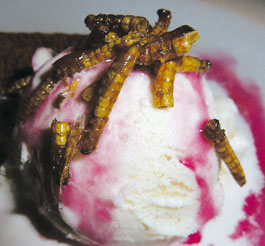home | north bay bohemian index | sonoma, napa, marin county restaurants | preview

Photograph by Stett Holbrook
CRAWLING IN LOVE: Yes, those are mealworms on ice cream, and, no, you don't have to eat them.
Full Squirm
Edible insects continue their trajectory as the next bug thing
By Stett Holbrook
It's only a matter of culture and geography that we ride horses instead of eating them. The same goes for cheese. While some cultures find eating fermented mammary gland secretions kind of gross, we love it, especially melted on top of the charred flesh of the same animals we raise for said mammary gland secretions. Go figure.
What we choose to eat isn't really much of a choice of at all. It's predetermined by our culture, and those cultural biases are hard to shake. Consider a readily available form of protein that is not only cheap and delicious, it's nutritionally dense and environmentally benign. It's got everything going for it except a little public-relations problem: it happens to be insects.
But culinary trend watchers take note: the buzz surrounding edible insects is building.
Last summer, San Francisco resident and artist Monica Martinez created an insect street food project called Don Bugito as part of the San Francisco Street Food Festival. She plans to open her food cart as a full-fledged business with the help of La Cocina, a food business incubator that focuses on women and immigrant communities.
"You're going to start seeing edible insects all over the Bay Area," says Martinez. "I'm not the only one doing this. Hopefully, it becomes very popular."
Martinez showcased her cooking before a standing-room only crowd last month at the Headlands Center for the Arts in Sausalito. I don't imagine the hundred or more attendees crowding into the old military mess hall at Fort Barry were particularly bold or adventurous eaters; the food was simply good, no holding of noses required. (I brought my seven-year-old son, and he had more trouble with the spiciness of some of the food rather than the fact he was eating bugs.)
Edible insects were a key component of pre-Hispanic cuisine in Mexico, so serving a Mexican-themed meal was a natural. The first dish was escamoles—bean-shaped ant eggs found in the roots of agave plants—with browned butter. The nutty, wonderfully rich eggs are only harvested in the rainy season, so this was a rare treat. Paired with pasilla peppers, corn and zucchini saut–ed in brown butter and served with fresh made blue corn tortillas, it was superb.
Next came a crunchy salad of toasted crickets, pumpkin seeds, jicama and sweet potato in a lime vinaigrette. While the crispy toffee mealworms (they taste just like bacon fat) over vanilla ice cream were good, better was the crispy wax moth larvae served on a rich corn custard with spicy tomato sauce and a sprinkling of cordyceps, a fungus with reputed medicinal properties which infects insect larvae with spores that germinate before the cocoons are formed.
Will edible insects become as popular as Martinez predicts? Probably not. But sushi was once considered crazy culinary exotica, something that no red-blooded American would eat. Now you can find raw fish at the lowliest shopping mall food court. Are mealworm tacos next? Free your mind and your stomach will follow.
For more information about Don Bugito and edible insects, see www.minilivestock.org.
Send a letter to the editor about this story.
|
|
|
|
|
|
